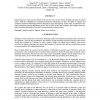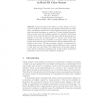122
click to vote
ICASSP
2011
IEEE
2011
IEEE
Beyond bag of words: Combining generative and discriminative models for natural scene categorization
14 years 4 months ago
This paper proposes a simple yet new and effective framework by combining generative model and discriminative model for natural scene categorization. A state-of-the-art approach f...
102
Voted
COGCOM
2011
14 years 8 months ago
2011
A less studied component of gaze allocation in dynamic real-world scenes is the time lag of eye movements in responding to dynamic attention-capturing events. Despite the vast amou...
105
Voted
HVEI
2009
14 years 10 months ago
2009
Range maps have been actively studied in the last few years in the context of depth perception in natural scenes. With the availability of co-registered luminance information, we ...
123
Voted
DPHOTO
2009
14 years 11 months ago
2009
Holistic representations of natural scenes are an effective and powerful source of information for semantic classification and analysis of arbitrary images. Recently, the frequenc...
136
Voted
NN
2006
Springer
15 years 1 months ago
2006
Springer
How does attention operate in natural scenes? We show that the receptive fields of inferior temporal cortex neurons that implement object representations become small and located ...
90
Voted
ICASSP
2010
IEEE
15 years 1 months ago
2010
IEEE
Natural scene statistics (NSS) are an active area of research. Although there exist elegant models for NSS, the statistics of natural image distortions have received little attent...
106
click to vote
ICPR
2002
IEEE
15 years 6 months ago
2002
IEEE
In this paper, we propose a robust approach for recognition of text embedded in natural scenes. Instead of using binary information as most other OCR systems do, we extract featur...
103
click to vote
ECCV
2010
Springer
15 years 6 months ago
2010
Springer
Occlusions provide critical cues about the 3D structure of man-made and natural scenes. We present a mathematical framework and algorithm to detect and localize occlusions in image...
101
Voted
DAGM
2004
Springer
15 years 6 months ago
2004
Springer
We propose an approach to categorize real-world natural scenes based on a semantic typicality measure. The proposed typicality measure allows to grade the similarity of an image wi...
111
click to vote
IWINAC
2005
Springer
15 years 6 months ago
2005
Springer
Abstract. Visual attention is the ability of a vision system, be it biological or artificial, to rapidly detect potentially relevant parts of a visual scene. The saliency-based mo...






